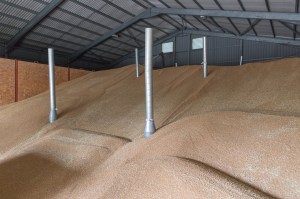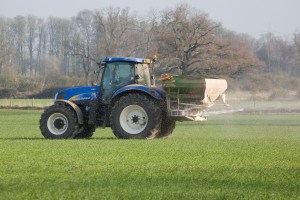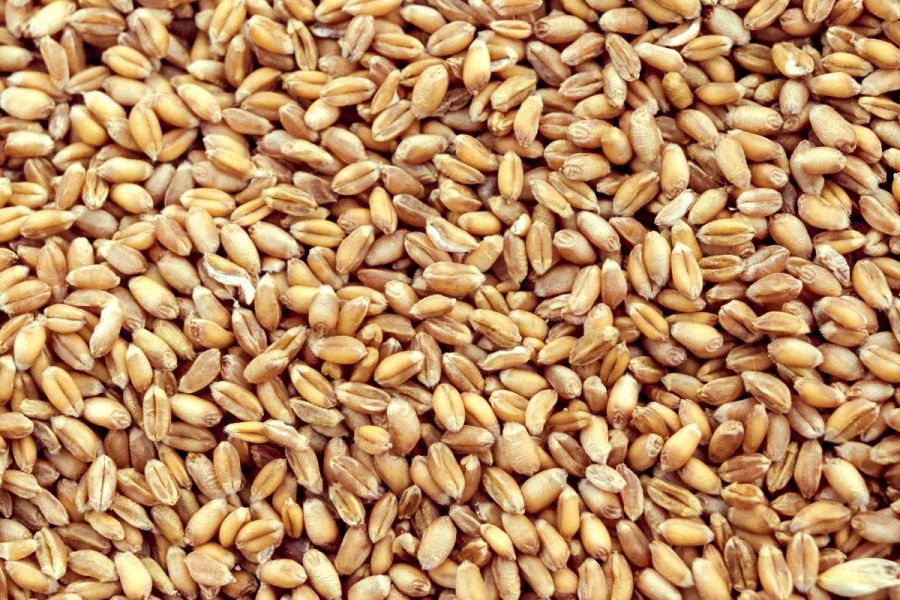As the year draws to a close, the past 12 months have seen some of the greatest volatility in commodity markets in recent history. CPM reflects on the farmgate challenges and considers the strategies for mitigating risk.
“I don’t have sleepless nights wondering whether or not I’ve sold at the right price.”
By Charlotte Cunningham
It’s somewhat poignant that the December 2021 issue of CPM featured an article on grain outlook and trading and began with the line: “Grain prices have been particularly buoyant this year – but global markets are notoriously volatile, so what does the future hold in store for harvest 2022?”
Just 12 months on, and it’s safe to say no one could have envisioned just how volatile the past year would be…
The war in Ukraine has no doubt proved to be the biggest influence on global markets, but trouble was brewing before Putin waged his war, with soaring fertiliser and fuel costs sending balance sheets spiralling and forcing many growers to relook at their operations, says Openfield’s Edward Hastie-Smith. “Prior to this, the world was in a pretty stable place, there were a few issues in places, but from a grain perspective, prices were hobbling along – over £200/t at the end of January.”

Wheat prices peaked at a high of about £340/t in May this year after India announced a brief ban on exports.
February came around and the war in Ukraine sent global grain and oilseed supplies into jeopardy. A lack of availability from the East tightened stocks, and the effect for the UK was extremely buoyant prices, says Edward, with grain value peaking towards the end of May when India announced briefly they were banning exports. “At that stage, the wheat prices were way up over £340/t for wheat – if you could get a market that is, as a lot of mills weren’t pricing due to the significant volatility.”
However, this wasn’t necessarily received at the farm gate. When it came to the appetite for risk for this season’s crops, many farmers chose not to sell a tonne of grain until it was in the shed, explains Edward. “With the turmoil going on across the world, there wasn’t much incentive to price a lot of grain. Speaking to colleagues and others in the industry there wasn’t that much grain sold over £300/t as some had already priced forward their set percentage at £200/t+ and there were drought concerns in the UK, so many were happy just to wait.”
The value – particularly for wheat – stayed at over £300/t well into June. But Edward says the most challenging part of this has been the range between the highs and lows of grain prices across the year – from a high of over £340/t for wheat and a low price of about £170/t. “We have seen a swing of close to £200/t in wheat prices – and we’re not even done with the year yet,” he notes. “I’ve been in the job for nine years and some of my colleagues have been supporting our members for 40 years, and no one has ever seen anything quite like this.”

Market volatility like this year’s has never been seen before, reckons Edward Hastie-Smith.
The difficulty with that is trying to advise farmers on what to do with their grain, when arguably, the only person with an insight on what may happen is Putin, warns Edward.
So with the grain market finding itself in such unprecedented times, how can growers protect themselves from volatility and maintain a margin?
For Warwickshire farmer Robin Turney, honing in on exact cost of production figures has been an integral part of the strategy this year.
Robin farms 900ha across the south of the county, growing oilseed rape, wheat, barley, beans and maize for anaerobic digestion. He also operates a 30,000t central grain store for local farmers, Openfield and others. He says the business has experienced a significant amount of change over the past 12 months. “Our biggest challenge has been trying to confirm what our cost of production was going to be for the 2023 harvest and drawing up a budget against likely market grain prices. But then by the time we got to February we could have thrown it in the bin quite frankly. At one point we were selling wheat at £170/t and then the next minute it was £300/t.”
The benefit of these inflated prices was short-lived however, amid a backdrop of rising input costs, he adds. “Likewise, we were buying fertiliser at £260-270/t (for ammonium nitrate), and then all of a sudden, we were having to pay up to £650/t. So the whole matrix of everything has changed.”
Though thankfully fertiliser needed for the 2022 harvest had been bought in advance of the worst of the price rises, when it came to relooking at the 2023 budget this had a huge impact on cashflow, explains Robin. “We were talking more than doubling the cost of purchases so we had discussions on whether we could mitigate some of the impact with some sales – and if so, we needed to know what our cost of production and margin aspirations were.”
This meant looking hard at both buying and marketing strategies. “Earlier than normal we were trying to refine our cropping plan, how much fertiliser we wanted to use compared with normal and what exposure to further market risk we were prepared for.”
To better manage and understand the risk, pool marketing has been essential this year, explains Robin. “We’ve historically grown in the region of 4000t of milling wheat and committed a third pre-harvest and two-thirds after.
“But as we couldn’t decide where the market was going, this year we were more inclined to lock more in when the price was strong to protect us from that rising cost of production. At this point in time, I’ve probably got about 30-40% of my crops in pools already.”
Regular communication with Openfield has aided this decision making, he adds. “My communication with the team is more regular than ever at the moment because of this volatility while I try to understand what the market is doing and what the fundamentals are on a weekly basis.”

Rob Atkin minimises his risk by spreading grain sales across pools, a producer’s contract and spot prices.
Nearby in the West Midlands, Staffordshire grower Rob Atkin has also been capitalising on the advice of the Openfield grain-marketing team to deflect the risk when it comes to selling his 400ha of combinable crops.
Like Robin, rising input costs have been a major challenge for Rob. “Fertiliser for me was bought quite well for last season – I always buy in the May and I paid about £270/t for it. Buying fertiliser this year has costed in at £640/t, so we’re now watching markets a lot more closely to work out when is the best time to buy.
“Diesel costs have gone up too and the same approach of being more wary applies to our chemistry usage – essentially, we’re just trying to manage our costs better. The difficulty with this is the weather and knowing when to go or when to hold off a spray.”
This closer eye on the market is also relevant to how Rob is approaching grain sales this year. “Everyone always wants the best price they can get, but for me, I’m more focused on trying to achieve a decent average across the whole tonnage. I know what I need to make to break even and make a bit of profit, so having a good average price will cover me.”
In terms of what this looks like practically sales-wise, Rob sells about 80% of his grain through Openfield. “We’ve been dealing with them for 30 years and what I like most is their model of how I can manage risk. So what we do is sell a quarter of our tonnage into their pool system, a quarter onto their producers direct (PD) contract, which offers freedom to discuss and define with Openfield the best strategy to market grain, but set for a month – not priced. A quarter is then on spot, but I’ll put that in a pool if necessary. The 20% is sold elsewhere.
“What I like about their pools is that we split it between autumn pools and late marketed spring pools and that takes the risk from me by not having to ring up every month to try to sell a certain tonnage at a certain price – they just do it for me.
“Every eight weeks I get a statement (monthly from October to July) with an estimated budget which is really helpful when I’m trying to work out cashflows.
“Then with their spot pricing, Openfield are very good and very clever with their forecasting so I know prices will never be below expectations. It means I don’t have sleepless nights wondering whether or not I’ve sold at the right price.”
In the Cotswolds, Ed Horton is taking a holistic approach to managing risk, based around operating a mixed farming system where arable and livestock enterprises are very much integrated and reaping the rewards from each other.
The arable enterprise spans across 3200ha, with a varied cropping plan which includes combinables as well as more niche crops like buckwheat and spelt.

Fertiliser costs have soared this year, putting upward pressure on cost of production.
Unlike Robin and Rob, fertiliser cost has had minimal impact on Ed due to his ability to incorporate the manure in place of the majority of his bagged fertiliser requirement. That said, he has still experienced a huge amount of volatility. “There has been variation of extremes of grain prices, input prices and weather. Energy prices have also risen, but the weather meant we didn’t have to spend on drying a single tonne of grain this year. However, it did cost us three times as much to cool everything. So it has been swings and roundabouts.”
Part of the solution to protect against this volatility is being more strategic with grain marketing and selling, explains Ed. “We grow a lot of niche crops, and I approach selling our spelt, for example, in quite an old-fashioned way.”
With the bulk, commodity crops, risk is tackled by aiming for milling specification to counteract the lower yields achieved on the Cotswold brash. Some of this is marketed through Openfield pools. “As much as I could sit and watch the markets every day, when that is someone’s full time job inherently, they’ve got a better idea than I have about when is best to sell,” explains Ed.
The rest of the sales are based on a ‘when the price is right’ approach, driven by Ed’s close attention to detail in terms of his cost of production and margin aspiration – meaning he knows exactly what price he needs to hit to cover this. “I work closely with Edward from Openfield on this too – he knows exactly where my set prices are and so we play the market in that respect.”
Looking at the future, this close relationship also aids the planning of further harvests, he says. “Edward and I analyse what is globally looking like it could be in demand and try to pre-plan the growing of commodities which are most likely to be wanted by an export market so that we can capitalise on our close proximity to Portbury Dock.”
So looking to the future, what can growers expect over the next 12 months? While much is unknown at this stage, globally there is a lot happening – from the continuation of the war in the Ukraine, to the drought in Argentina and closer to home the potential impact of reduced feed demand – which could positively or negatively impact grain prices, says Edward. “It’s an uncertain picture at the moment and needs to be watched closely.”
Therefore, the overarching advice from him is to consult with the experts if there is uncertainty over how growers can best market their grain and mitigate risk. “Know your costs, pay attention to the market, set target prices and take advantage of industry knowledge. If we take Openfield’s pools as an example, they performed incredibly well over the past few years – probably some of the top performers in the country. And then there’s also our crop fund which is totally unique to Openfield members and really helps them with cash advances on committed tonnage to aid cash flow and contra payments for seed and fertiliser in these very challenging times. That really does just help to take the risk away from growers.”
Better buying, better selling
To remain at the forefront of arable farming and to maximise the value from every hectare of crop grown requires a keen understanding of the grain market, the seed to supply it, and the fertiliser to feed the crop.
Through this series of articles, CPM is working with Openfield to provide a market insight and help farmers to focus on these major business decisions to ensure better buying of inputs, and better selling of the produce.
Openfield is Britain’s only national farming grain-marketing and arable inputs co-operative and is owned by over 4000 arable farmers. Openfield’s team works with a total of 6000 farmers to supply some of the biggest and best-known names in the British food and drink manufacturing industry.

But there’s more than just grain to Openfield, supplying seed and fertiliser, providing grain storage and offering expert advice on grain marketing and risk management. This delivers innovative supply chain solutions to its farmer members and consumer customers.
This article was taken from the latest issue of CPM. For more articles like this, subscribe here.




